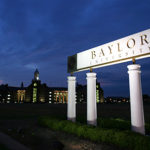WACO—Baylor University announced Dec. 11 one of its two American black bear mascots, Lady, has been undergoing radiation therapy for a benign tumor in her chest.
Veterinarians at Texas A&M College of Veterinary Medicine & Biomedical Sciences discovered the cranial mediastinal mass, or thymoma, next to her heart during a routine wellness examination in the summer.
Lady, formally known as Judge Sue “Lady” Sloan, completed noninvasive radiation treatments at the Texas A&M Veterinary Medical Teaching Hospital in College Station. The bear will be monitored closely and assessed by her care team to ensure her comfort and recovery, the university reported.
In a letter to the “Baylor Family,” President Linda Livingstone said Lady was back on the campus in Waco and resting comfortably at the Bill and Eva Williams Bear Habitat, where she lives with her older biological sister, Joy.
“Baylor University celebrates many beloved traditions, but few bring as much joy to students, alumni and friends and as many rich opportunities to interact with and educate young people in Central Texas as our live bear mascots, Joy and Lady. They are a cherished part of the Baylor Family,” Livingstone wrote.
“The veterinarians have begun a course of TomoTherapy we hope will reduce the size of the tumor—a treatment that is believed to be the first ever done on a bear. We are grateful to have access to a remarkable team with the expertise needed for Lady’s care.
“Our priority is Lady’s comfort and wellbeing. Following the treatments, we will visit again with the veterinary team. We are optimistic about the results and Lady’s health.”
Aggie vets treat Baylor bear
The mass was discovered in June during a regular wellness visit under the direction of Sharman Hoppes, an exotic animal specialist with Texas A&M College of Veterinary Medicine & Biomedical Sciences. A CT scan in July confirmed the mass as thymoma, a tumor that affects the thymus, an organ near the lungs that is part of the lymphatic and immune systems.
In August, the bear was treated with a low-dose TomoTherapy System, a treatment that targets tumors while minimizing exposure of radiation to surrounding healthy tissues and causing fewer side effects compared to conventional forms of radiation therapy. On Dec. 2 and Dec. 11-12, Lady received additional treatments.
Sign up for our weekly edition and get all our headlines in your inbox on Thursdays
“It shows a great level of care and respect Baylor has for these animals by bringing them to us at a specialist facility,” said J. Jill Heatley, zoological medicine specialist at Texas A&M College of Veterinary Medicine & Biomedical Sciences. “Not everybody would do this, so it is important to note that is beyond the standard level of care.”
The veterinarians treating Lady said this particular tumor never had been observed in a living bear early enough to treat due to its asymptomatic nature, with no external physical or behavioral symptoms that would indicate a problem. The only previous case of thymoma in a bear was not evident until an autopsy was performed. Veterinarians have closely monitored Lady’s tumor, which is benign and has not grown since it was discovered.
“The good news for Lady is that she has no clinical signs of the mass, which means that we caught it early,” said Lauren Smith, radiation oncologist and clinical assistant professor at Texas A&M College of Veterinary Medicine & Biomedical Sciences.
“Thymomas are typically diagnosed when they’re so large in size that they’re compressing the heart and the lungs, causing difficulty breathing or lethargy. As we have been establishing the best treatment plan for Lady, the tumor has remained stable in size on advanced imaging. Being able to intervene at an early point is why we have a very positive outlook for her.
“We are still able to treat this in an aggressive manner using the advanced technology while ensuring that she is able to be at home with her sister, able to eat and drink normally and able to have a good quality of life.”














We seek to connect God’s story and God’s people around the world. To learn more about God’s story, click here.
Send comments and feedback to Eric Black, our editor. For comments to be published, please specify “letter to the editor.” Maximum length for publication is 300 words.